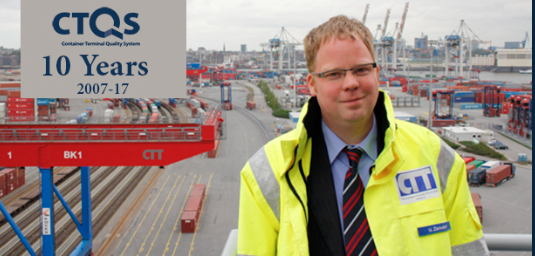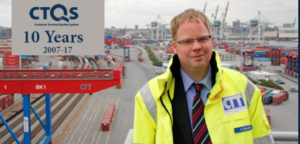
CTA
Best in Class
Lorem ipsum dolor sit amet, consectetur adipiscing elit. Ut elit tellus, luctus nec ullamcorper mattis, pulvinar dapibus leo.

CTA THE FIRST TERMINAL WORLDWIDE TO BE CERTIFIED WITH THE CTQS STANDARD
Container Terminal Altenwerder (CTA) is one of three container terminals operated by Hamburger Hafen und Logistik AG (HHLA) at the Hamburg Port. It is designed to discharge large containerships efficiently and, thanks to its high automation level, experts consider it the most modern container terminal in the world. The terminal has been operating since June 2002 and was initially designed to handle a capacity of 1.9 million standard containers.
However this was already exceeded by 2006. Performance and total capacity of the terminal are continuously being enhanced thanks to further developments such as new gantry cranes, additional automatic transport vehicles, improved storage capacity as well as better IT-supported container handling processes. HHLA is one of the leading port logistic companies in the European North Range.
Before the introduction of the CTQS standard CTA already used various quality management tools.
These included:
- Comprehensive documentation of operational processes (concepts, workflow descriptions)
- Output and productivity reporting
- Regular management meetings (including presentation of target values and achieved results)
- HHCT benchmarking
- Use of the terminal “top list“ (a comparison of North European terminals)
- They evaluated their performance by analysing their own statistics and records and using components of quality management systems like process descriptions, manuals and internal audits.
- CTA experienced the change from project to company and made big efforts to maintain and improve quality
- Therefore CTA wanted to have quality efforts checked by an external audit.
In 2008 CTA became the first terminal worldwide to be certified with the new CTQS standard. Given the growing size of container ships, issues such as speed, safety and cost efficiency of container terminals are more important than ever. The CTQS certification system measures and documents performance level and quality standards of container terminals.
The certification according to CTQS showed that CTA’s process organisation and performance met the requirements. At the same time, the certification stimulated the CTA team to further improve performance.
The first audit results showed that terminal operation is structured transparently. It is largely automated and dominated by clear information and communication structures as well as goal-oriented actions. The second terminal extension shows that terminal technology is continuously developing.
MPLEMENTATION OF CTQS AT TOLLERORT
In 2015 HHLA’s second terminal at Toolerort implemented the Container Terminal Quality System and was subsequently certified by DNVGL here Ulf Zielsdorf, Commercial Manager and Head of Projects at the terminal explains the background to the program
What is the new quality management system at Tollerort?
Mr. Zielsdorf, you have introduced a new quality management system, the “Container Terminal Quality Indicator” (CTQI), at the Container Terminal Tollerort. What does this mean?
By introducing a standardised quality management system, such as the one also used at Container Terminal Altenwerder, we can see how we compare to other terminals around the world. This also requires us to adhere to standards, which have either been stipulated by the system, or those which we have introduced ourselves.
Ulf Zielsdorf, Commercial Manager
and Head of Projects Tollerort
What was required for the launch?
We needed to become fully aware of our processes again. And we have evaluated numerous predefined key figures – performance data such as containers handled, terminal capacity or infrastructure factors including quay length and access for heavy goods vehicles. Furthermore, we have written an organisational handbook and reviewed internally whether the processes function in the way in which we have defined them to do so.
Which terminal areas took part?
All of them. Anyone who could make a contribution did so. Arne Schöneberg, the quality management officer, and the six internally trained auditors all made especially big contributions in this area.
How long did the introduction take?
In total, it took around a year and a half. We have collected the key figures for the reference year 2013.
What will the new quality management system achieve?
We hope that it will enable us to identify weaknesses, which we can then counteract. Compliance with the prescribed standards is reviewed annually by Det Norske Veritas/Germanischer Lloyd. The system therefore allows us to challenge ourselves anew every year, which in turn means that we can also address any weaknesses every year and are able to continuously improve.
THE CONTAINER TERMINAL QUALITY SYSTEM
The Container Terminal Quality System (CTQS) is a strategic planning and management system that is used to align business activities to the vision and strategy of the organization, improve internal and external communications, and monitor organization performance against strategic goals.
CTQS sets an audited independent measure of container terminal efficiency. The proposed system is expected to increase the transparency of the container industry and provide a meaningful measurement of container terminal performance.
The benchmarking system measures the terminal performance within the supply chain process. The result offers the port industry new dimensions: Shippers will now be able to choose terminals that best suit to their needs and supply chain strategy.
To qualify for a CTQS audit, a terminal has to implement a management system which ensures a continual improvement process amongst other key performance indicators.
Internal and external factors will be evaluated through the certification scheme. Auditors assess criteria such as properly-dimensioned cranes and their performance or the efficiency of loading and unloading trains, trucks and inland vessels. The audit includes organisational aspects, such as opening hours of the road gate, communication and planning skills and capabilities, as well as adequate connectivity with the hinterland and the inland waterway system.
The detailed point evaluation enables a qualified discussion between terminal operators, shippers, cargo owners, port authorities, shipping companies and other stakeholders. It is up to the terminals how much of this information they wish to share as all certified figures and achieved benchmarks are only disclosed in a confidential annex to the certificate.
CTQS is more than a simple performance measurement framework; it is a full strategic planning and management system. CTQS transforms an organization’s strategic plan from a passive document into the “marching orders” for the organization on a daily basis.
CTQS is a management system as well as a measurement system. It enables Terminal Operators to clarify their vision and strategy and translate them into action. It provides feedback around both the internal processes and external outcomes of the business in order to continuously improve strategic performance and results.
When fully deployed, CTQS transforms strategic planning from an academic exercise into the nerve centre of an enterprise.
8 YEARS OF CONTINUOUS IMPROVEMENT BUILT ON CTQS
Since the launch of CTQS (Container Terminal Quality System) in 2008, and the subsequent certification of the first terminal CTA in Hamburg, the Institute has been monitoring the effect of implementing the system. We now know that the system achieves two key objectives, firstly it is a tool to demonstrate ‘Best in Class’ status, secondly it acts as a continuous improvement tool which may be implemented at any terminal with, or without certification.
CASE STUDY:
CTA, already one of the most efficient terminals in the world, has seen enhancements in productivity and efficiency through the implementation of the CTQI and the use of the key performance indicators to identify and rectify bottlenecks and problem areas. These improvements have returned an on-going financial benefit to the terminal. We believe this benefit can be replicated elsewhere at other container terminals, and we refer to this programme for continuous improvement as the Container Terminal Quality System.
HAMBURGER HAFEN UND LOGISTIK AG
Hamburger Hafen und Logistik AG (HHLA) is a leading European port and transport logistics groups. At its hubs in the ports of Hamburg and Odessa as well as inland, the company links three different carriers – ships, trains and trucks – to create a powerful logistics chain which set economic and ecological standards. The three high-performance terminals in Hamburg make the port the most important container hub between Asia and Central/Eastern Europe. With their network of connections, their own terminals, locomotives and wagons the rail companies operate high-performance container transportation services from the ports on the North and Baltic seas, the Central and Eastern Europe hinterland to the Adriatic and Turkey.
HUB FOR CONTAINERS
Business model of HHLA
HHLA links logistical processes together in an intelligent manner. The company handles import and export containers, loading and discharging them between mega-ships, feeder ships, train and truck carriers in the container terminals located at the ports. HHLA’s rail companies connect the terminals in the ports with a network of hub and inland terminals in the Central and Eastern European hinterland. 1.3 million standard containers (TEU) were transported via this network of very frequent rail connections in 2014. In each handling process, the containers are sorted with increasing accuracy according to destination regions (colours). The “final mile” to the customer is then usually covered by truck. This intelligent link between container handling and transportation brings ports and the hinterland closer together.
Container throughput 2015: 6.6 million standard containers (TEU)
Container transport 2015: 1.3 TEU
SEGMENTS
As a leading European port and transport logistics group, HHLA with its Container, Intermodal and Logistics segments is positioned along the transport chain between the overseas port and the European hinterland. In its Real Estate segment HHLA is shaping structural change, developing its estate and enlarging logistics potential.
CONTAINER
HHLA’s highly efficient container terminals Altenwerder, Burchardkai and Tollerort ensure the Port of Hamburg’s supreme importance as a logistics hub. Technical innovations and automated working processes ensure high productivity and short laytimes. Specialized companies offer all box-related services, whether repair or storage of empty containers or handling of project and heavy cargo. HHLA also operates a container terminal in Odessa.
INTERMODAL
HHLA’s Metrans and Polzug intermodal companies connect Hamburg and other ports with Central, Eastern and South-Eastern Europe via a comprehensive connection and terminal network. The density, frequency and reliability of the connections on offer are the hallmarks of a quality rail transport service that is both economically and ecologically attractive. Container forwarder CTD undertakes positioning of containers in the port of Hamburg and the immediate proximity of important economic centres.
LOGISTICS
HHLA’s logistics segment pools an assortment of port-related services, thereby supporting Hamburg’s leading role as an all-purpose port. At O’Swaldkai, subsidiaries and associated companies also handle fruits, containers and project cargo, alongside vehicles and rolling cargo. With Hansaport, HHLA also holds a stake in Germany’s largest terminal for coal and ore. The Hamburg Port Consulting (HPC) consultancy markets HHLA’s expertise in infrastructure and project development around the world.

